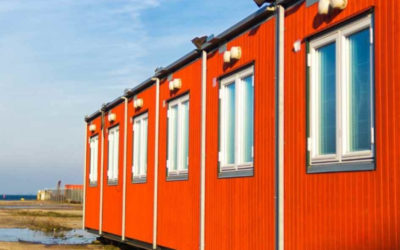Once just the backbone of international trade, transporting goods across vast oceans, the humble shipping container has been reborn in the hands of innovative architects and builders. Picture this: a bustling construction site where instead of piles of bricks and cement mixers, you see stacks of rectangular metal boxes waiting to be transformed into modern, sustainable dwellings.
What seemed like a fantastical idea a decade ago is now a tangible reality in many parts of the world. The once-overlooked shipping container is now at the forefront of a construction revolution, offering a solution to issues of sustainability, affordability, and efficient building practices. This surprising metamorphosis from a simple object of logistics to a revolutionary building material is a testament to human resourcefulness and creativity.
What are shipping containers and their history in transportation?
Shipping containers, also known as intermodal containers, are large, standardised boxes used for the transportation of goods via ship, rail, or lorry. Designed to be easily transferred between these different modes of transport, they have played a pivotal role in the globalisation of commerce, simplifying the logistics of shipping and handling a vast array of goods across long distances.

The concept of the modern shipping container was born around the mid-20th century. Prior to this, goods were commonly loaded and unloaded onto ships individually, a laborious process known as break-bulk shipping. This method was time-consuming, inefficient, and prone to theft. In 1956, American entrepreneur Malcolm McLean, a former trucking industry tycoon, introduced the concept of containerisation. McLean’s innovative design was a reusable steel box that could be securely closed, protecting its contents and facilitating easy loading and unloading. This sped up the transportation process dramatically, reducing costs and increasing efficiency.
Despite initial resistance and various technical challenges, the shipping container’s impact was transformative. It revolutionised the transportation industry by standardising dimensions, thereby, streamlining the loading and unloading process, reducing cargo handling, and minimising the risk of theft. Since then, the use of shipping containers has expanded globally, and today, it is estimated that there are over 17 million shipping containers in circulation worldwide. Their influence extends beyond transportation; as noted earlier, they are now being repurposed in innovative ways, such as in the construction industry.
Why are shipping containers so important in the construction industry
Shipping containers are gaining prominence in the construction industry due to several key factors. Firstly, they offer an innovative approach to sustainable construction. As reusable materials, they significantly reduce the need for new resources and contribute to waste minimisation. Secondly, they provide a cost-effective alternative to traditional building materials. The cost of purchasing and modifying a shipping container for residential or commercial use is often considerably less than the cost of building from scratch.
Thirdly, shipping containers offer efficiency in terms of construction time. Projects using shipping containers can be completed much faster than traditional builds, as the primary structure is already fabricated. Lastly, the versatility of shipping containers allows for a myriad of design possibilities. They can be stacked, laid side by side, or placed end to end, providing the flexibility to create unique, customised spaces. The incorporation of shipping containers in construction signifies a shift towards more environmentally conscious, efficient, and innovative building practices.
Advantages of using shipping containers in construction
Shipping containers bring a host of advantages when used in construction.
- Sustainability: The use of shipping containers is a form of upcycling, transforming an object into something of equal or greater value in its second life. This practice can help reduce the carbon footprint of construction projects by stemming the demand for new materials and reducing waste.
- Affordability: Container homes are generally cheaper to build than traditional homes. This affordability comes from the fact that the main structure of the building is already formed. This only leaves the modification costs which are lesser compared to starting a construction project from scratch.
- Speed of Construction: The time it takes to modify shipping containers into a liveable space is considerably less than the time taken to build a traditional home or office space from the ground up. This can be a significant advantage for those needing a quick solution.
- Design Flexibility: The modular nature of containers allows for diverse and imaginative architectural designs. Their strong structure allows for creative stacking, making it possible to add multiple levels, and encouraging designers to think beyond a traditional single-storey layout.
- Durability: Shipping containers are designed to withstand harsh conditions, making them exceptionally sturdy and durable. They are resistant to natural disasters, such as hurricanes and earthquakes, providing an added layer of security for occupants.
Using shipping containers for construction is not only a trend but also a move towards sustainable and affordable living. It’s a testament to human ingenuity, proving that with a bit of creativity, we can repurpose just about anything into something useful and attractive.
Innovative uses of shipping containers in construction
In Australia, the innovative use of shipping containers in construction is gaining significant momentum, pushing the boundaries of sustainable architecture. A prime example of this is the ‘Graceville Container House’ in Brisbane, designed by Todd Miller of Ziegler Build. This striking three-story residence, constructed from 31 shipping containers, is a testament to the design flexibility and durability of shipping containers, featuring a saltwater pool, a 5-car garage, and a rooftop terrace.
In Melbourne, Sean Godsell’s Future Shack demonstrates the potential for shipping containers to provide disaster relief housing. The prototype, which can be folded and transported with ease, is designed to provide an immediate, self-contained shelter solution following natural calamities, highlighting the speed of construction associated with shipping containers.
These examples underscore the increasing adoption and diverse application of shipping containers in construction in Australia, validating their potential as affordable, quick, and sustainable building materials.
Case studies – real-life examples of successful projects using shipping containers in Australia
The Beach Box
One of the most incredible examples of shipping container homes in Australia is the Beach Box in Bunbury, Western Australia. Built by architect Paul Meschiati, this home is a stunning eco-friendly beach shack created using repurposed shipping containers. It has a luxurious feel and boasts large glass doors that open onto a beautiful deck, creating the perfect blend of indoor and outdoor living spaces. The design proves that sustainability and luxury can coexist, offering a new perspective on the potential of shipping container homes.
The Huiini House
The Huiini House in Perth, Western Australia, by the architectural firm Terra Studio, is another great example of innovative design using shipping containers. The home, made from four shipping containers, uses passive solar design principles, insulating paint, and a green roof to maximise energy efficiency. The thoughtful design ensures natural light fills the interiors, creating a bright and vibrant living space. This project underscores the possibilities of marrying sustainability with aesthetics in shipping container constructions.
These two real-life projects demonstrate that shipping container homes can not only be sustainable and affordable but also offer a high degree of architectural sophistication and elegance. They serve as powerful testimonials for the transformative potential of this unconventional building material in the Australian housing market. You can see more of Australia’s best shipping container homes in a recent article on RealEstate.com.au
Future potential and trends of shipping container construction
Looking forward, the future potential of shipping container construction in Australia appears promising. As sustainable and affordable housing solutions become increasingly important, these unconventional homes are set to play an essential role in the Australian housing market. More and more architects and builders are exploring this avenue, pushing the boundaries of what’s possible with shipping container designs.

In terms of trends, the move towards greener, more eco-friendly living is influencing the designs of these homes. Expect to see more shipping containers featuring solar panels, rainwater collection systems, and energy-efficient insulation. What’s more, biophilic design principles, which aim at incorporating nature into architectural design, are also being utilised, with many shipping container homes featuring indoor plants, natural light, and materials.
Furthermore, multi-purpose and adaptable living spaces are becoming popular in the design of these homes. As homeowners seek to maximise their space, shipping containers are being transformed into everything from home offices to guest accommodations. With their versatility and modular nature, shipping containers provide an excellent solution for those looking for a flexible and adaptable living situation.
Overall, the future of shipping container construction in Australia looks bright, with many exciting developments on the horizon. They are transforming from a niche housing option into a mainstream solution, offering a viable answer to many of the challenges faced by the Australian housing market.
Conclusion
In conclusion, shipping container homes represent a progressive, sustainable, and versatile solution within the construction industry. They combine innovative design principles with eco-friendly practices, making a significant contribution towards reducing the industry’s carbon footprint. Solar panels and rainwater collection systems help to lessen the homes’ environmental impact and promote a more sustainable lifestyle. Embracing a biophilic approach to design, these homes can seamlessly integrate with the natural surroundings, enhancing occupants’ wellbeing.
In terms of flexibility, shipping containers can be adapted to serve multiple purposes, from home offices to guest accommodations, reflecting the growing need for space optimisation within the modern home. Their modular nature allows for easy and cost-effective modifications, making these homes an appealing choice for those seeking adaptability.
The rise of shipping container homes in the Australian market suggests a promising future for this form of construction. As a viable alternative to traditional housing, they can help to address the challenges in the Australian housing market. Given the benefits they offer and their growing popularity, shipping container homes are poised to have a transformative impact on the construction industry, evolving from a niche choice to a mainstream housing solution.
OZBOX: Leading the Way in Shipping Container Solutions
At OZBOX, we have quickly emerged as a leading supplier of shipping containers for hire and sale in Australia, shining a light on the transformative impact that shipping container homes can have. OZBOX has a huge range of shipping containers in all sizes including 20ft containers and 40ft containers, in addition to speciality containers such as high cube and insulated shipping containers that are perfect for use in shipping container homes.
Get in touch with the team today to find out more.









